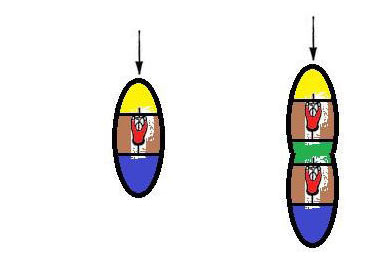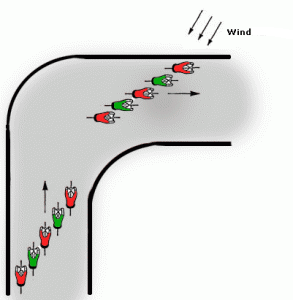seeking shelter from the wind
Echeloning: practical and magical at the same time
Echeloning is one of the most beautiful parts of a group ride. There, you will discover how much faster and easier it is when you work well together. You, as a group of riders, become a single organism, a machine that can be far more powerfull than the separate individuals. If that machine also happens to run smoothly, you feel a special kind of magic.
Smart use of the wind
On a bike, you almost always experience a headwind. If it’s not the real wind, it’s the airflow you create yourself by moving forward.

Everyone knows just how tough it can be to ride on your own. As a group you can cleverly deal with the wind. By riding in an echelon, you are now riding on the lee side or even in the wake of another rider.

Not only the man or woman behind the rider in front benefit, but also the person in front has advantage when someone is riding (closely) behind him.
Resistance consists of:
1. Pressure wave at the front (yellow)
2. Lack of aerodynamics (brown)
3. Zog, swirls on the back (blue)
That the rear riders have an advantage is right with our feeling. But the front rider also has an advantage because the whirls behind him partly disappear by the man behind him. The green resistance part is divided by both riders and is smaller than the blue and yellow together of both individual riders
But how do you, as a group of racing cyclists, deal as efficiently as possible, with headwinds? By riding in an echelon.
Getting out of the wind
The front rider rides as much as possible on the windward side of the road and the others ride on the other, the leeward, side, away from the wind.

With low winds, those who ride on the second row can better determine where the wind comes from than the front rider: you seek that position behind the front rider where you feel the least amount of wind.
If the wind comes right against the head, it is difficult to find that favorable position. The shielding surface is much smaller than with wind against at an angle. So feel which position is the most favorable. It may be that for number three that is a bit different than for number two. And so on.
The leader must be coached
Because the leader cannot always determine where the wind comes from, those on the second row coach the front rider: “bit left”, or “bit right”.
See also: Signals
Elbows: anticipating change of wind direction
On a long straight road you only need to determine once where the wind comes from and how to form your group. But if the course twists and turns that can become difficult. Suppose the wind blows from right, so the front rider rides on the far right side of the road. Now suppose there is a sharp right turn coming up. What does the front rider do? He or she makes the right turn, but less sharply as he or she would do if alone. As a matter of fact, he or she swerves to the other side of the road. After all after the turn the wind will no longer come from the right, but from the left. The rest will tuck in, now on the right hand side from the lead rider. It is useful to determine before the turn where the wind will be coming from after the turn. Then you, as lead rider, can move over to the correct side of the road after the turn right away, and your group will follow smoothly behind you without any problem. It is important to mention that shortly before taking the turn, all riders should stop riding with overlapping wheels.
See also: Anticipation and slowly make changes
Communication
When riding in an echelon, especially when you’re riding on your limits, communication and cooperation is crucial in order to always be in the ideal position relative to each other.
See also: Driving Range and communication and collaboration
See also: Driving in groups / communication and cooperation
There are basically three different types of echelons: the single echelon, the double echelon, and the multiple echelons.

